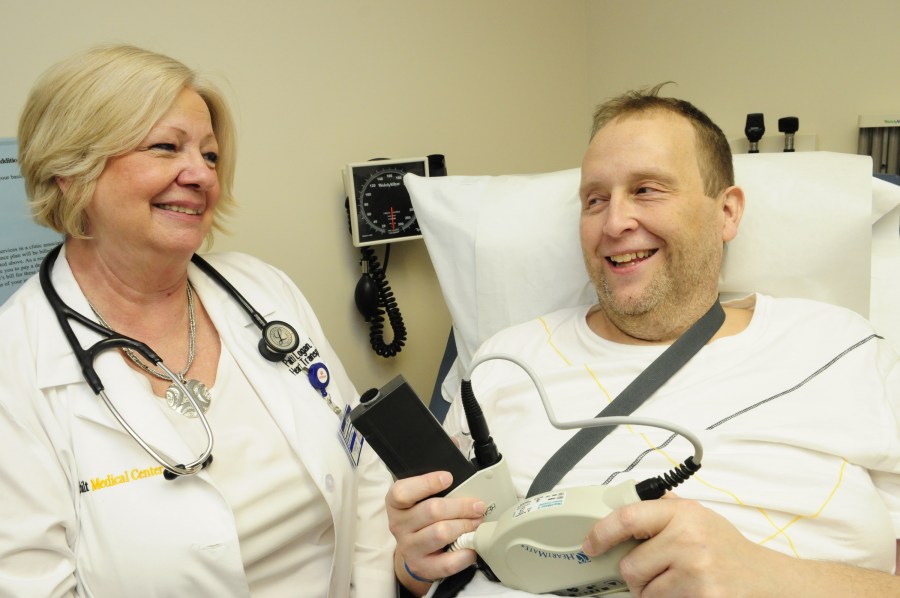
Vanderbilt Heart patient Michael Stanbery talks with Patti Logan, R.N., about the new Heart failure, Exercise and Lifestyle program Stanbery is participating in. (photo by Mary Donaldson)
Program offers heart patients exercise, lifestyle assistance
Michael Stanbery of Morristown, Tenn., had his chest opened and a pump, known as a left ventricular assist device (LVAD), implanted near his heart to help the organ, weakened by cardiomyopathy, do its job.
It was major surgery, and he has the scar to prove it. Because LVAD placement does not fit neatly into the category of “open heart surgery,” his insurance denied coverage for outpatient cardiac rehab, which would help return him to an active, healthy lifestyle. He could not afford the $1,000 per week out-of-pocket fee.
It's a scenario that Jeremy McNatt, an exercise physiologist with the Dayani Center, has seen too many times, primarily in senior citizens who are in heart failure. Medicare denies coverage for cardiac rehab, and the patients go home and resume their unhealthy lifestyle and end up back in the hospital.
For this reason, McNatt started a program about a year ago called H.E.L.P. (Heart failure, Exercise and Lifestyle Program). It offers most of the same benefits of cardiac rehab, but at a fraction of the cost. The six-week program, which meets twice a week, costs $90. Stanbery was among the first patients to enroll.
“The weeks before I had surgery, I could barely walk across the living room. Now, after having the LVAD implanted and finishing H.E.L.P., I am able to do stuff with my nieces and nephews again, and I am even planning a trip to the beach,” said Stanbery, who is 46 and was diagnosed with cardiomyopathy 10 years ago. He is currently on the heart transplant waiting list.
The H.E.L.P. program provides a baseline assessment, including heart rate and blood pressure monitoring, a customized exercise program and education on how to lead a healthy lifestyle. What it does not include is ECG monitoring, a cornerstone of traditional outpatient cardiac rehab.
“Since they don't qualify for that monitoring, we've taken that part out of it. Otherwise, it's the same type of care they'd get in outpatient cardiac rehab. The exercise component is the same. The education component is the biggest difference,” McNatt said.
“During the first month of the program we hit topics like healthy eating, reading food labels, how to meal plan, good choices when eating out. We discuss the benefits of exercise. We focus on signs and symptoms they should look for so they know when to call the doctor.”
About 15 patients have completed the program since its inception. McNatt gets referrals from cardiology nurse practitioners and would like to see the program grow.
“Those patients who have come through have done really well,” McNatt said. “Most — 80 percent or more — have reached their goals after 12 to 24 visits. They are amazed at how much they have accomplished.”













